Legal System for Business Law - Desklib
VerifiedAdded on 2021/06/11
|9
|2654
|279
AI Summary
This article explains how market laws and regulations are essential for the organization's operations and how they affect decision-making and other activities. The overall report is split into four parts, each of which focuses on a separate set of issues. The first part delves into the English legal system and the many rules that businesses must adhere to. In addition, the government's position in lawmaking is debated. The effectiveness of the legal system, as well as changes within it, was discussed in order to get a better understanding. Moving on, the key points of various market laws have been clarified, as well as their applicability in various case studies. Finally, there was a contrast between regulatory regimes and complementary legal guidance. This report will provide clarity on the British, and more specifically English, legislation nowadays.
Contribute Materials
Your contribution can guide someone’s learning journey. Share your
documents today.
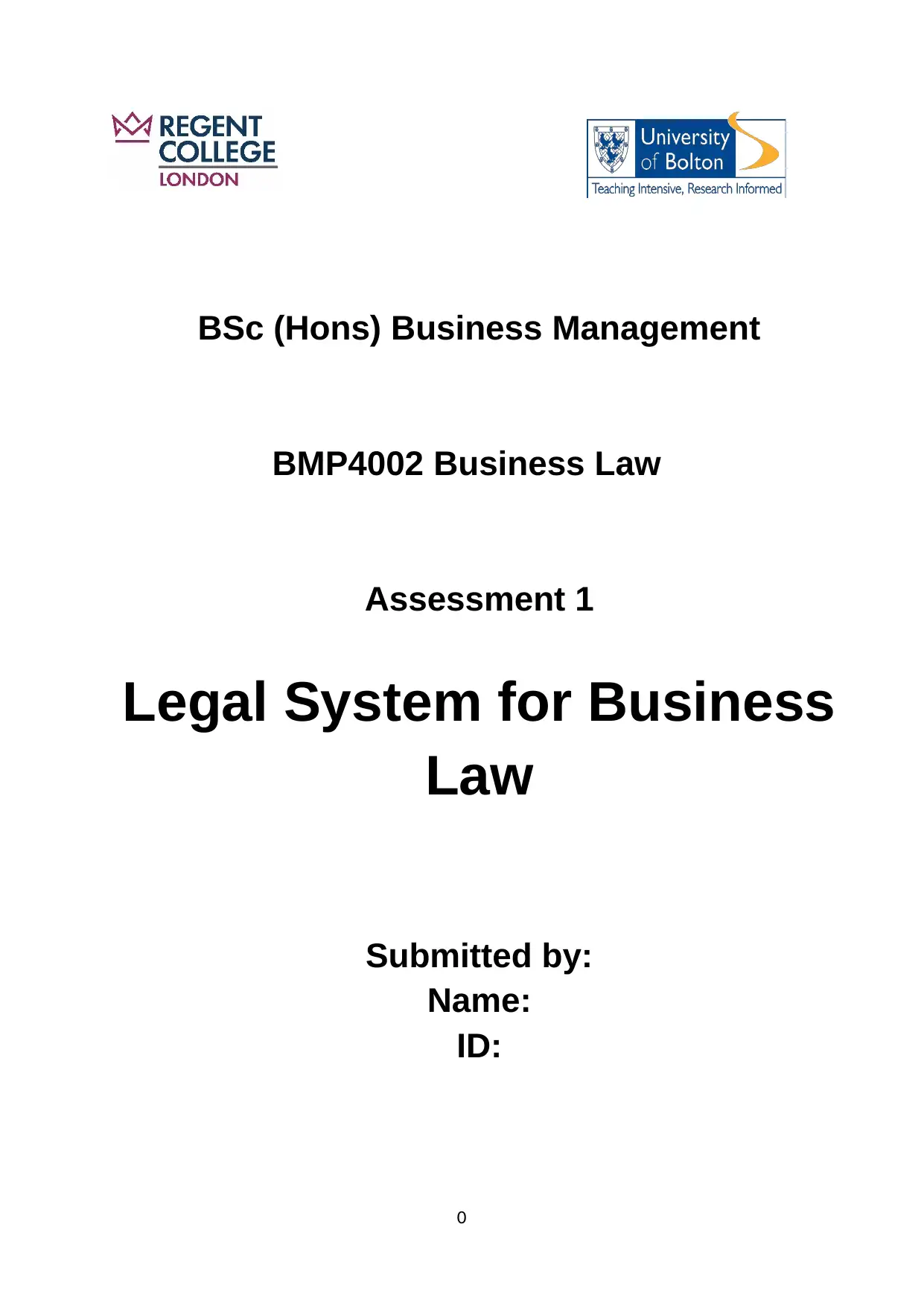
BSc (Hons) Business Management
BMP4002 Business Law
Assessment 1
Legal System for Business
Law
Submitted by:
Name:
ID:
0
BMP4002 Business Law
Assessment 1
Legal System for Business
Law
Submitted by:
Name:
ID:
0
Secure Best Marks with AI Grader
Need help grading? Try our AI Grader for instant feedback on your assignments.
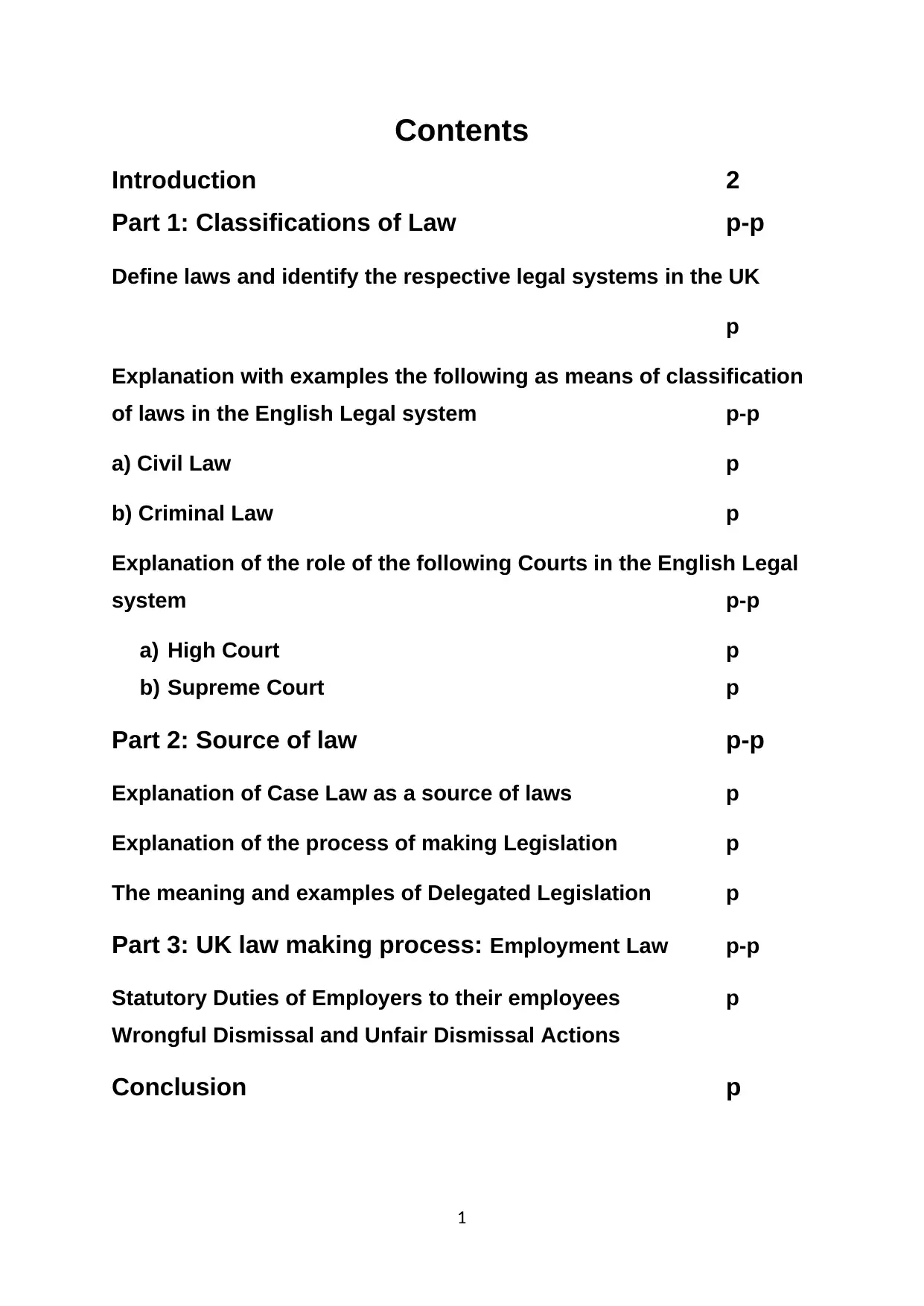
Contents
Introduction 2
Part 1: Classifications of Law p-p
Define laws and identify the respective legal systems in the UK
p
Explanation with examples the following as means of classification
of laws in the English Legal system p-p
a) Civil Law p
b) Criminal Law p
Explanation of the role of the following Courts in the English Legal
system p-p
a) High Court p
b) Supreme Court p
Part 2: Source of law p-p
Explanation of Case Law as a source of laws p
Explanation of the process of making Legislation p
The meaning and examples of Delegated Legislation p
Part 3: UK law making process: Employment Law p-p
Statutory Duties of Employers to their employees p
Wrongful Dismissal and Unfair Dismissal Actions
Conclusion p
1
Introduction 2
Part 1: Classifications of Law p-p
Define laws and identify the respective legal systems in the UK
p
Explanation with examples the following as means of classification
of laws in the English Legal system p-p
a) Civil Law p
b) Criminal Law p
Explanation of the role of the following Courts in the English Legal
system p-p
a) High Court p
b) Supreme Court p
Part 2: Source of law p-p
Explanation of Case Law as a source of laws p
Explanation of the process of making Legislation p
The meaning and examples of Delegated Legislation p
Part 3: UK law making process: Employment Law p-p
Statutory Duties of Employers to their employees p
Wrongful Dismissal and Unfair Dismissal Actions
Conclusion p
1
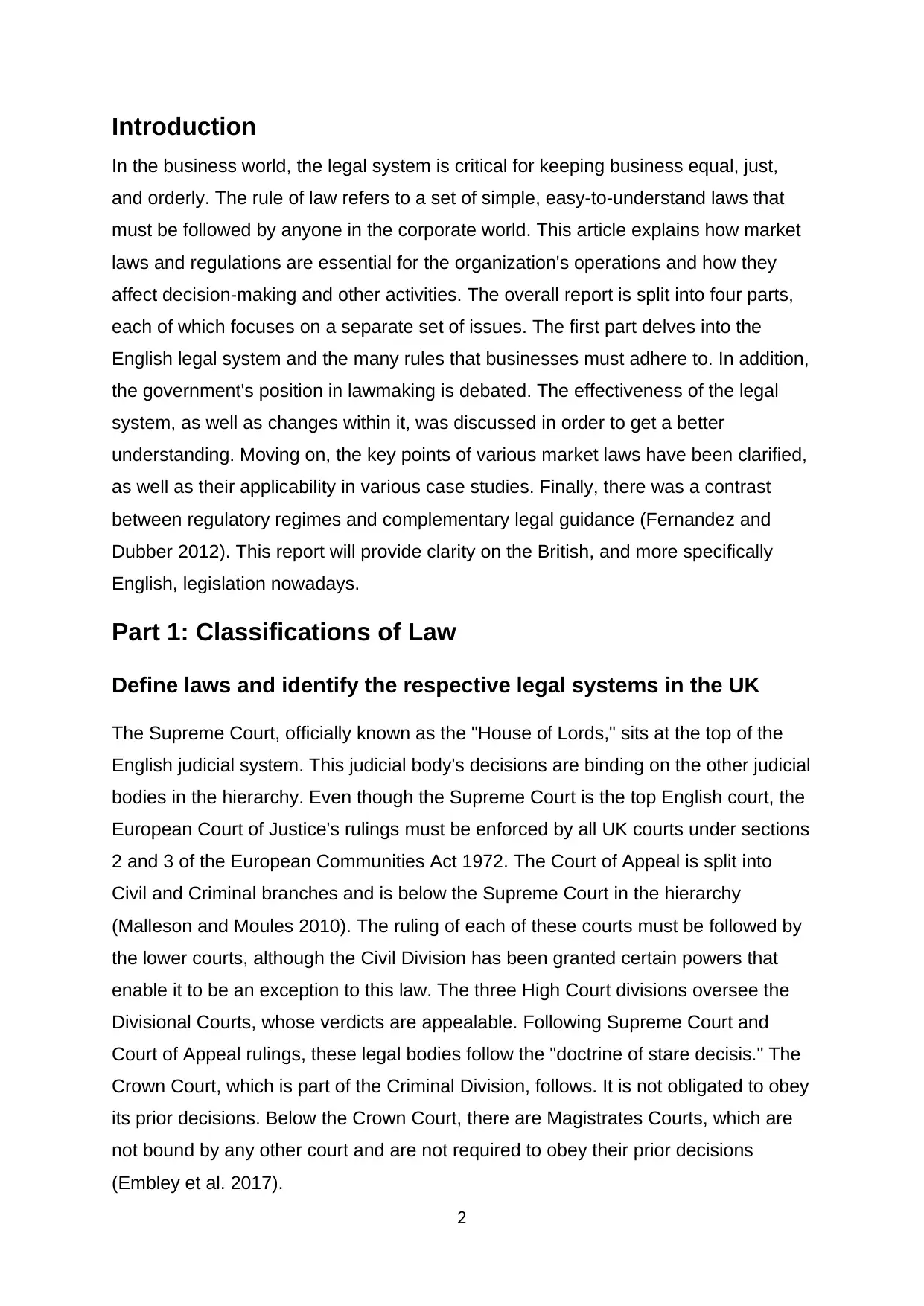
Introduction
In the business world, the legal system is critical for keeping business equal, just,
and orderly. The rule of law refers to a set of simple, easy-to-understand laws that
must be followed by anyone in the corporate world. This article explains how market
laws and regulations are essential for the organization's operations and how they
affect decision-making and other activities. The overall report is split into four parts,
each of which focuses on a separate set of issues. The first part delves into the
English legal system and the many rules that businesses must adhere to. In addition,
the government's position in lawmaking is debated. The effectiveness of the legal
system, as well as changes within it, was discussed in order to get a better
understanding. Moving on, the key points of various market laws have been clarified,
as well as their applicability in various case studies. Finally, there was a contrast
between regulatory regimes and complementary legal guidance (Fernandez and
Dubber 2012). This report will provide clarity on the British, and more specifically
English, legislation nowadays.
Part 1: Classifications of Law
Define laws and identify the respective legal systems in the UK
The Supreme Court, officially known as the "House of Lords," sits at the top of the
English judicial system. This judicial body's decisions are binding on the other judicial
bodies in the hierarchy. Even though the Supreme Court is the top English court, the
European Court of Justice's rulings must be enforced by all UK courts under sections
2 and 3 of the European Communities Act 1972. The Court of Appeal is split into
Civil and Criminal branches and is below the Supreme Court in the hierarchy
(Malleson and Moules 2010). The ruling of each of these courts must be followed by
the lower courts, although the Civil Division has been granted certain powers that
enable it to be an exception to this law. The three High Court divisions oversee the
Divisional Courts, whose verdicts are appealable. Following Supreme Court and
Court of Appeal rulings, these legal bodies follow the "doctrine of stare decisis." The
Crown Court, which is part of the Criminal Division, follows. It is not obligated to obey
its prior decisions. Below the Crown Court, there are Magistrates Courts, which are
not bound by any other court and are not required to obey their prior decisions
(Embley et al. 2017).
2
In the business world, the legal system is critical for keeping business equal, just,
and orderly. The rule of law refers to a set of simple, easy-to-understand laws that
must be followed by anyone in the corporate world. This article explains how market
laws and regulations are essential for the organization's operations and how they
affect decision-making and other activities. The overall report is split into four parts,
each of which focuses on a separate set of issues. The first part delves into the
English legal system and the many rules that businesses must adhere to. In addition,
the government's position in lawmaking is debated. The effectiveness of the legal
system, as well as changes within it, was discussed in order to get a better
understanding. Moving on, the key points of various market laws have been clarified,
as well as their applicability in various case studies. Finally, there was a contrast
between regulatory regimes and complementary legal guidance (Fernandez and
Dubber 2012). This report will provide clarity on the British, and more specifically
English, legislation nowadays.
Part 1: Classifications of Law
Define laws and identify the respective legal systems in the UK
The Supreme Court, officially known as the "House of Lords," sits at the top of the
English judicial system. This judicial body's decisions are binding on the other judicial
bodies in the hierarchy. Even though the Supreme Court is the top English court, the
European Court of Justice's rulings must be enforced by all UK courts under sections
2 and 3 of the European Communities Act 1972. The Court of Appeal is split into
Civil and Criminal branches and is below the Supreme Court in the hierarchy
(Malleson and Moules 2010). The ruling of each of these courts must be followed by
the lower courts, although the Civil Division has been granted certain powers that
enable it to be an exception to this law. The three High Court divisions oversee the
Divisional Courts, whose verdicts are appealable. Following Supreme Court and
Court of Appeal rulings, these legal bodies follow the "doctrine of stare decisis." The
Crown Court, which is part of the Criminal Division, follows. It is not obligated to obey
its prior decisions. Below the Crown Court, there are Magistrates Courts, which are
not bound by any other court and are not required to obey their prior decisions
(Embley et al. 2017).
2
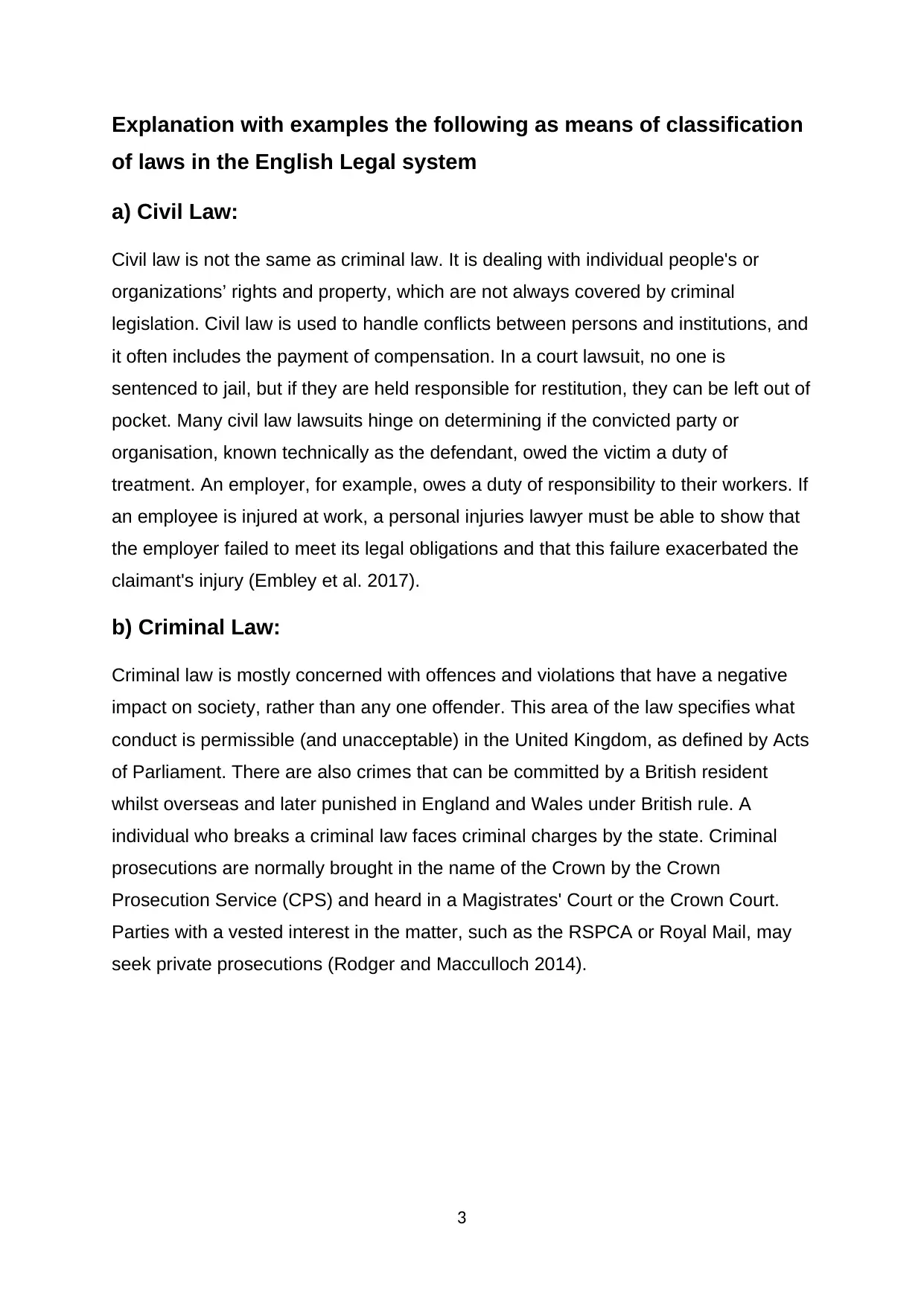
Explanation with examples the following as means of classification
of laws in the English Legal system
a) Civil Law:
Civil law is not the same as criminal law. It is dealing with individual people's or
organizations’ rights and property, which are not always covered by criminal
legislation. Civil law is used to handle conflicts between persons and institutions, and
it often includes the payment of compensation. In a court lawsuit, no one is
sentenced to jail, but if they are held responsible for restitution, they can be left out of
pocket. Many civil law lawsuits hinge on determining if the convicted party or
organisation, known technically as the defendant, owed the victim a duty of
treatment. An employer, for example, owes a duty of responsibility to their workers. If
an employee is injured at work, a personal injuries lawyer must be able to show that
the employer failed to meet its legal obligations and that this failure exacerbated the
claimant's injury (Embley et al. 2017).
b) Criminal Law:
Criminal law is mostly concerned with offences and violations that have a negative
impact on society, rather than any one offender. This area of the law specifies what
conduct is permissible (and unacceptable) in the United Kingdom, as defined by Acts
of Parliament. There are also crimes that can be committed by a British resident
whilst overseas and later punished in England and Wales under British rule. A
individual who breaks a criminal law faces criminal charges by the state. Criminal
prosecutions are normally brought in the name of the Crown by the Crown
Prosecution Service (CPS) and heard in a Magistrates' Court or the Crown Court.
Parties with a vested interest in the matter, such as the RSPCA or Royal Mail, may
seek private prosecutions (Rodger and Macculloch 2014).
3
of laws in the English Legal system
a) Civil Law:
Civil law is not the same as criminal law. It is dealing with individual people's or
organizations’ rights and property, which are not always covered by criminal
legislation. Civil law is used to handle conflicts between persons and institutions, and
it often includes the payment of compensation. In a court lawsuit, no one is
sentenced to jail, but if they are held responsible for restitution, they can be left out of
pocket. Many civil law lawsuits hinge on determining if the convicted party or
organisation, known technically as the defendant, owed the victim a duty of
treatment. An employer, for example, owes a duty of responsibility to their workers. If
an employee is injured at work, a personal injuries lawyer must be able to show that
the employer failed to meet its legal obligations and that this failure exacerbated the
claimant's injury (Embley et al. 2017).
b) Criminal Law:
Criminal law is mostly concerned with offences and violations that have a negative
impact on society, rather than any one offender. This area of the law specifies what
conduct is permissible (and unacceptable) in the United Kingdom, as defined by Acts
of Parliament. There are also crimes that can be committed by a British resident
whilst overseas and later punished in England and Wales under British rule. A
individual who breaks a criminal law faces criminal charges by the state. Criminal
prosecutions are normally brought in the name of the Crown by the Crown
Prosecution Service (CPS) and heard in a Magistrates' Court or the Crown Court.
Parties with a vested interest in the matter, such as the RSPCA or Royal Mail, may
seek private prosecutions (Rodger and Macculloch 2014).
3
Secure Best Marks with AI Grader
Need help grading? Try our AI Grader for instant feedback on your assignments.
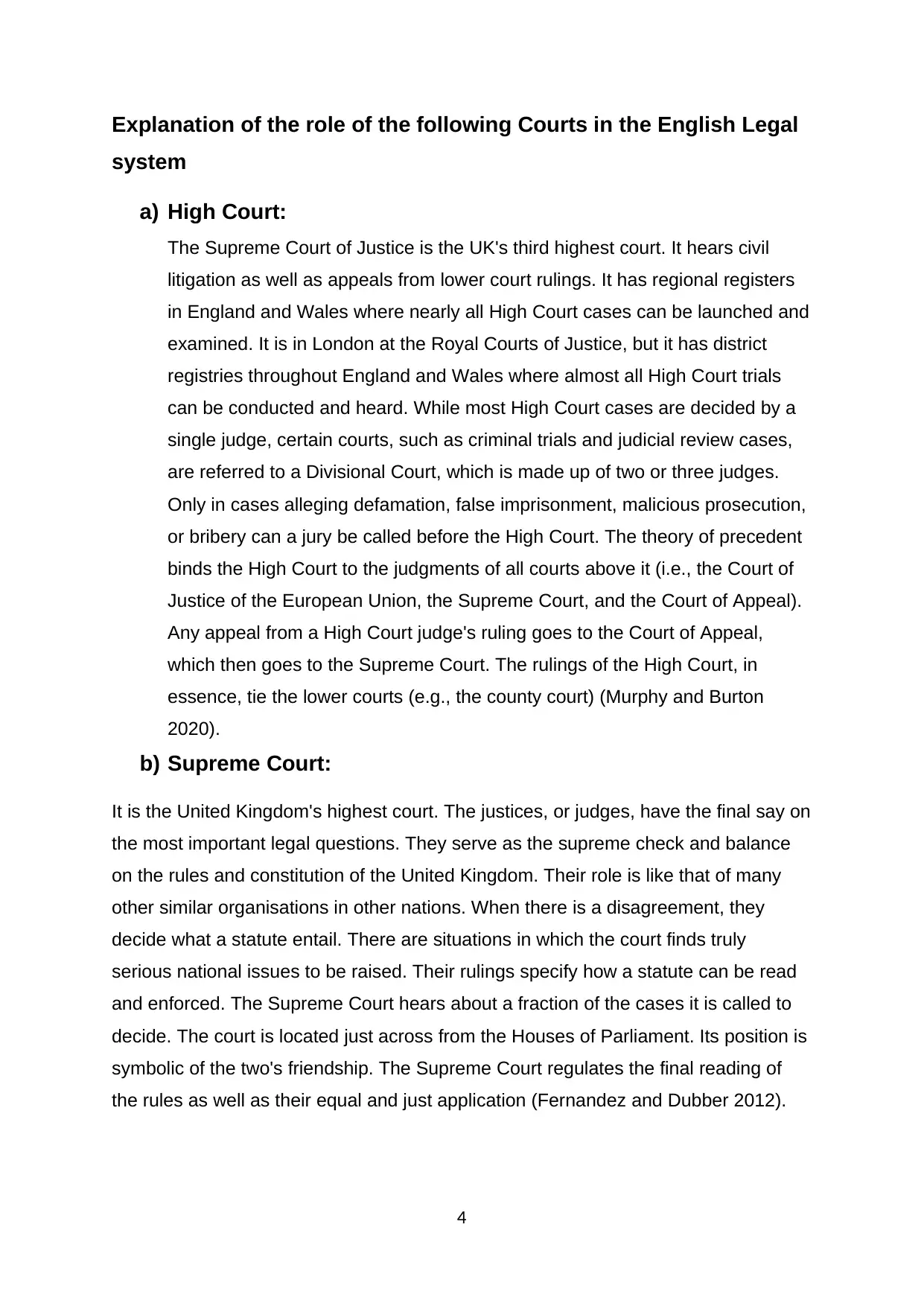
Explanation of the role of the following Courts in the English Legal
system
a) High Court:
The Supreme Court of Justice is the UK's third highest court. It hears civil
litigation as well as appeals from lower court rulings. It has regional registers
in England and Wales where nearly all High Court cases can be launched and
examined. It is in London at the Royal Courts of Justice, but it has district
registries throughout England and Wales where almost all High Court trials
can be conducted and heard. While most High Court cases are decided by a
single judge, certain courts, such as criminal trials and judicial review cases,
are referred to a Divisional Court, which is made up of two or three judges.
Only in cases alleging defamation, false imprisonment, malicious prosecution,
or bribery can a jury be called before the High Court. The theory of precedent
binds the High Court to the judgments of all courts above it (i.e., the Court of
Justice of the European Union, the Supreme Court, and the Court of Appeal).
Any appeal from a High Court judge's ruling goes to the Court of Appeal,
which then goes to the Supreme Court. The rulings of the High Court, in
essence, tie the lower courts (e.g., the county court) (Murphy and Burton
2020).
b) Supreme Court:
It is the United Kingdom's highest court. The justices, or judges, have the final say on
the most important legal questions. They serve as the supreme check and balance
on the rules and constitution of the United Kingdom. Their role is like that of many
other similar organisations in other nations. When there is a disagreement, they
decide what a statute entail. There are situations in which the court finds truly
serious national issues to be raised. Their rulings specify how a statute can be read
and enforced. The Supreme Court hears about a fraction of the cases it is called to
decide. The court is located just across from the Houses of Parliament. Its position is
symbolic of the two's friendship. The Supreme Court regulates the final reading of
the rules as well as their equal and just application (Fernandez and Dubber 2012).
4
system
a) High Court:
The Supreme Court of Justice is the UK's third highest court. It hears civil
litigation as well as appeals from lower court rulings. It has regional registers
in England and Wales where nearly all High Court cases can be launched and
examined. It is in London at the Royal Courts of Justice, but it has district
registries throughout England and Wales where almost all High Court trials
can be conducted and heard. While most High Court cases are decided by a
single judge, certain courts, such as criminal trials and judicial review cases,
are referred to a Divisional Court, which is made up of two or three judges.
Only in cases alleging defamation, false imprisonment, malicious prosecution,
or bribery can a jury be called before the High Court. The theory of precedent
binds the High Court to the judgments of all courts above it (i.e., the Court of
Justice of the European Union, the Supreme Court, and the Court of Appeal).
Any appeal from a High Court judge's ruling goes to the Court of Appeal,
which then goes to the Supreme Court. The rulings of the High Court, in
essence, tie the lower courts (e.g., the county court) (Murphy and Burton
2020).
b) Supreme Court:
It is the United Kingdom's highest court. The justices, or judges, have the final say on
the most important legal questions. They serve as the supreme check and balance
on the rules and constitution of the United Kingdom. Their role is like that of many
other similar organisations in other nations. When there is a disagreement, they
decide what a statute entail. There are situations in which the court finds truly
serious national issues to be raised. Their rulings specify how a statute can be read
and enforced. The Supreme Court hears about a fraction of the cases it is called to
decide. The court is located just across from the Houses of Parliament. Its position is
symbolic of the two's friendship. The Supreme Court regulates the final reading of
the rules as well as their equal and just application (Fernandez and Dubber 2012).
4
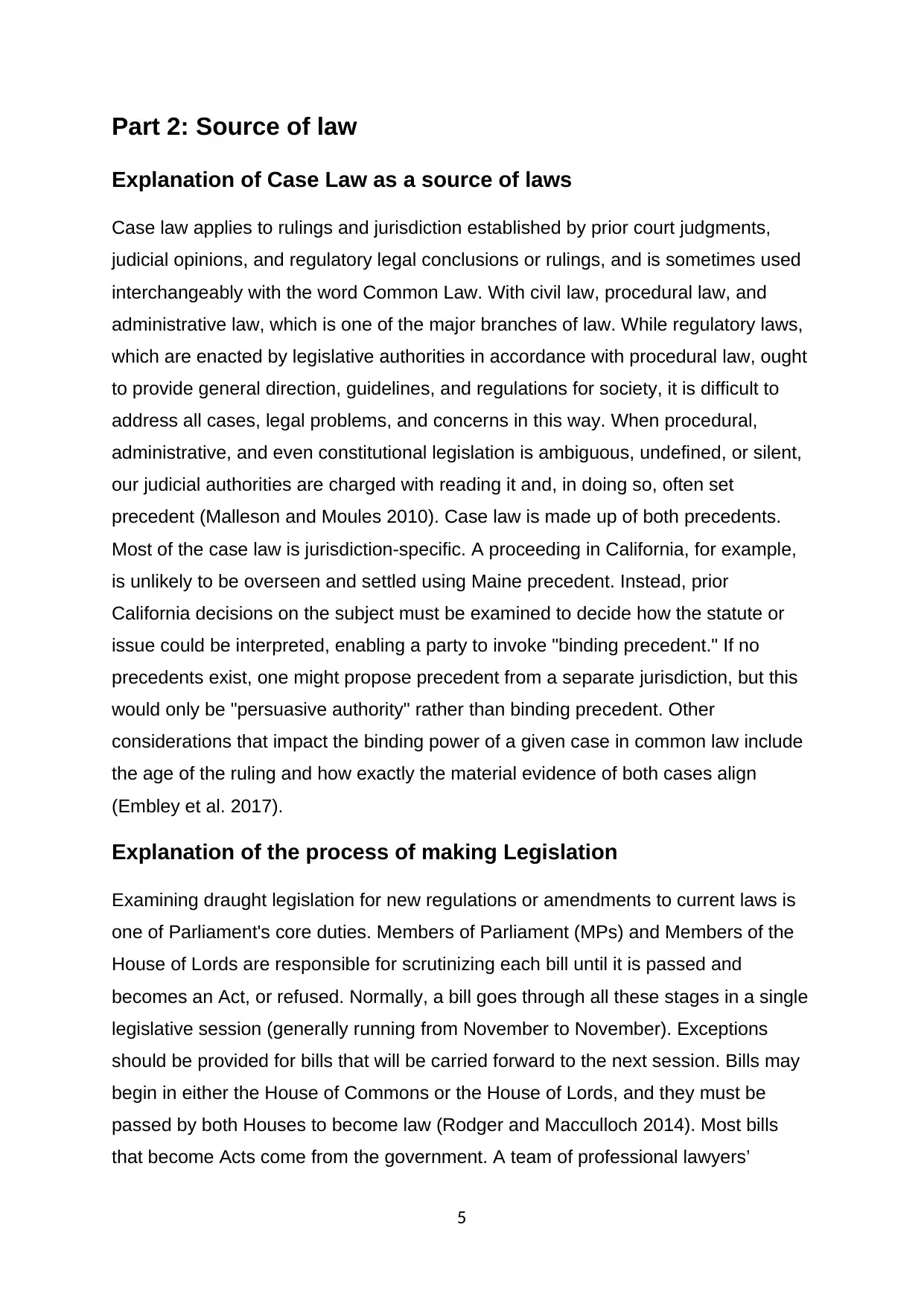
Part 2: Source of law
Explanation of Case Law as a source of laws
Case law applies to rulings and jurisdiction established by prior court judgments,
judicial opinions, and regulatory legal conclusions or rulings, and is sometimes used
interchangeably with the word Common Law. With civil law, procedural law, and
administrative law, which is one of the major branches of law. While regulatory laws,
which are enacted by legislative authorities in accordance with procedural law, ought
to provide general direction, guidelines, and regulations for society, it is difficult to
address all cases, legal problems, and concerns in this way. When procedural,
administrative, and even constitutional legislation is ambiguous, undefined, or silent,
our judicial authorities are charged with reading it and, in doing so, often set
precedent (Malleson and Moules 2010). Case law is made up of both precedents.
Most of the case law is jurisdiction-specific. A proceeding in California, for example,
is unlikely to be overseen and settled using Maine precedent. Instead, prior
California decisions on the subject must be examined to decide how the statute or
issue could be interpreted, enabling a party to invoke "binding precedent." If no
precedents exist, one might propose precedent from a separate jurisdiction, but this
would only be "persuasive authority" rather than binding precedent. Other
considerations that impact the binding power of a given case in common law include
the age of the ruling and how exactly the material evidence of both cases align
(Embley et al. 2017).
Explanation of the process of making Legislation
Examining draught legislation for new regulations or amendments to current laws is
one of Parliament's core duties. Members of Parliament (MPs) and Members of the
House of Lords are responsible for scrutinizing each bill until it is passed and
becomes an Act, or refused. Normally, a bill goes through all these stages in a single
legislative session (generally running from November to November). Exceptions
should be provided for bills that will be carried forward to the next session. Bills may
begin in either the House of Commons or the House of Lords, and they must be
passed by both Houses to become law (Rodger and Macculloch 2014). Most bills
that become Acts come from the government. A team of professional lawyers’
5
Explanation of Case Law as a source of laws
Case law applies to rulings and jurisdiction established by prior court judgments,
judicial opinions, and regulatory legal conclusions or rulings, and is sometimes used
interchangeably with the word Common Law. With civil law, procedural law, and
administrative law, which is one of the major branches of law. While regulatory laws,
which are enacted by legislative authorities in accordance with procedural law, ought
to provide general direction, guidelines, and regulations for society, it is difficult to
address all cases, legal problems, and concerns in this way. When procedural,
administrative, and even constitutional legislation is ambiguous, undefined, or silent,
our judicial authorities are charged with reading it and, in doing so, often set
precedent (Malleson and Moules 2010). Case law is made up of both precedents.
Most of the case law is jurisdiction-specific. A proceeding in California, for example,
is unlikely to be overseen and settled using Maine precedent. Instead, prior
California decisions on the subject must be examined to decide how the statute or
issue could be interpreted, enabling a party to invoke "binding precedent." If no
precedents exist, one might propose precedent from a separate jurisdiction, but this
would only be "persuasive authority" rather than binding precedent. Other
considerations that impact the binding power of a given case in common law include
the age of the ruling and how exactly the material evidence of both cases align
(Embley et al. 2017).
Explanation of the process of making Legislation
Examining draught legislation for new regulations or amendments to current laws is
one of Parliament's core duties. Members of Parliament (MPs) and Members of the
House of Lords are responsible for scrutinizing each bill until it is passed and
becomes an Act, or refused. Normally, a bill goes through all these stages in a single
legislative session (generally running from November to November). Exceptions
should be provided for bills that will be carried forward to the next session. Bills may
begin in either the House of Commons or the House of Lords, and they must be
passed by both Houses to become law (Rodger and Macculloch 2014). Most bills
that become Acts come from the government. A team of professional lawyers’
5
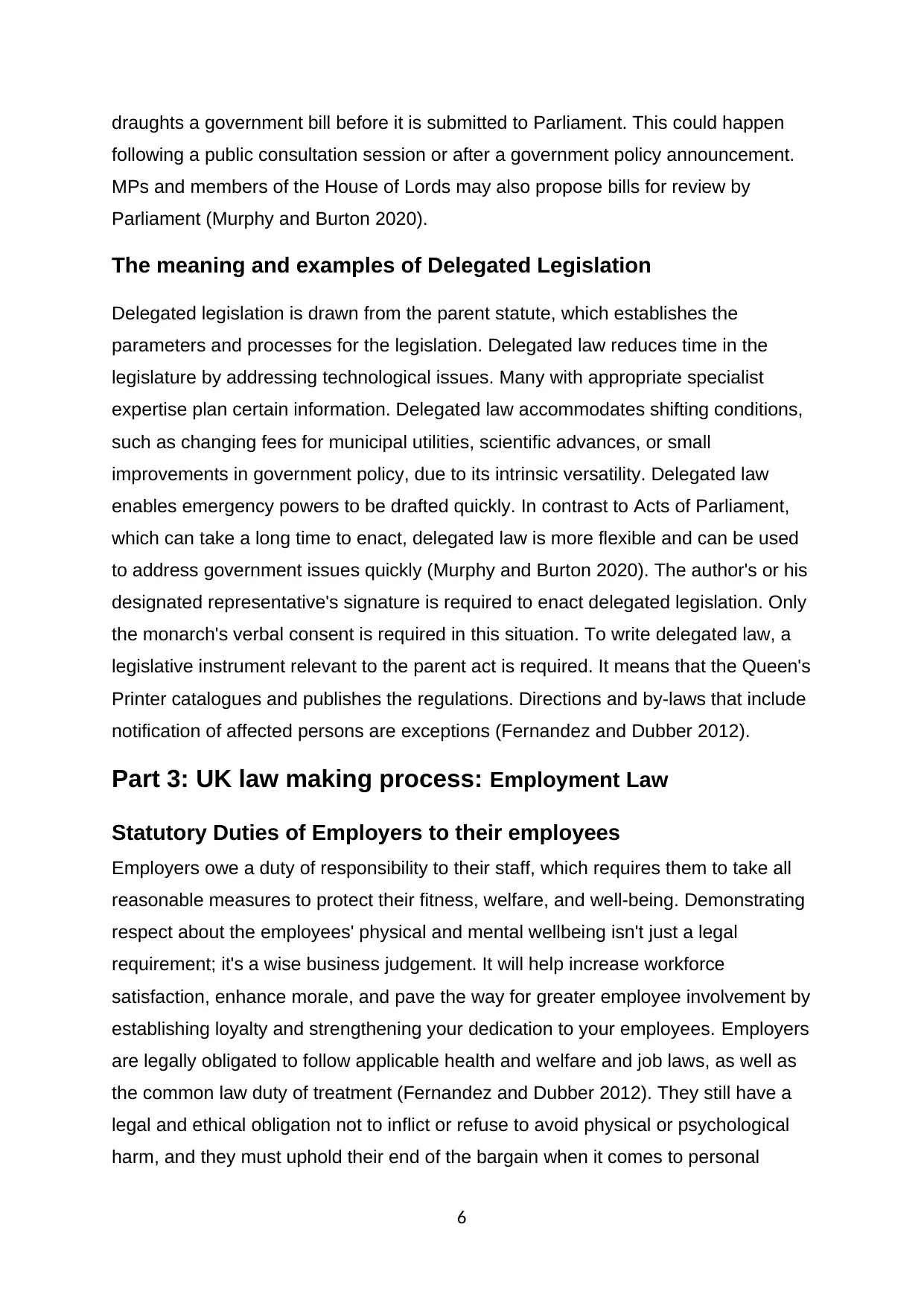
draughts a government bill before it is submitted to Parliament. This could happen
following a public consultation session or after a government policy announcement.
MPs and members of the House of Lords may also propose bills for review by
Parliament (Murphy and Burton 2020).
The meaning and examples of Delegated Legislation
Delegated legislation is drawn from the parent statute, which establishes the
parameters and processes for the legislation. Delegated law reduces time in the
legislature by addressing technological issues. Many with appropriate specialist
expertise plan certain information. Delegated law accommodates shifting conditions,
such as changing fees for municipal utilities, scientific advances, or small
improvements in government policy, due to its intrinsic versatility. Delegated law
enables emergency powers to be drafted quickly. In contrast to Acts of Parliament,
which can take a long time to enact, delegated law is more flexible and can be used
to address government issues quickly (Murphy and Burton 2020). The author's or his
designated representative's signature is required to enact delegated legislation. Only
the monarch's verbal consent is required in this situation. To write delegated law, a
legislative instrument relevant to the parent act is required. It means that the Queen's
Printer catalogues and publishes the regulations. Directions and by-laws that include
notification of affected persons are exceptions (Fernandez and Dubber 2012).
Part 3: UK law making process: Employment Law
Statutory Duties of Employers to their employees
Employers owe a duty of responsibility to their staff, which requires them to take all
reasonable measures to protect their fitness, welfare, and well-being. Demonstrating
respect about the employees' physical and mental wellbeing isn't just a legal
requirement; it's a wise business judgement. It will help increase workforce
satisfaction, enhance morale, and pave the way for greater employee involvement by
establishing loyalty and strengthening your dedication to your employees. Employers
are legally obligated to follow applicable health and welfare and job laws, as well as
the common law duty of treatment (Fernandez and Dubber 2012). They still have a
legal and ethical obligation not to inflict or refuse to avoid physical or psychological
harm, and they must uphold their end of the bargain when it comes to personal
6
following a public consultation session or after a government policy announcement.
MPs and members of the House of Lords may also propose bills for review by
Parliament (Murphy and Burton 2020).
The meaning and examples of Delegated Legislation
Delegated legislation is drawn from the parent statute, which establishes the
parameters and processes for the legislation. Delegated law reduces time in the
legislature by addressing technological issues. Many with appropriate specialist
expertise plan certain information. Delegated law accommodates shifting conditions,
such as changing fees for municipal utilities, scientific advances, or small
improvements in government policy, due to its intrinsic versatility. Delegated law
enables emergency powers to be drafted quickly. In contrast to Acts of Parliament,
which can take a long time to enact, delegated law is more flexible and can be used
to address government issues quickly (Murphy and Burton 2020). The author's or his
designated representative's signature is required to enact delegated legislation. Only
the monarch's verbal consent is required in this situation. To write delegated law, a
legislative instrument relevant to the parent act is required. It means that the Queen's
Printer catalogues and publishes the regulations. Directions and by-laws that include
notification of affected persons are exceptions (Fernandez and Dubber 2012).
Part 3: UK law making process: Employment Law
Statutory Duties of Employers to their employees
Employers owe a duty of responsibility to their staff, which requires them to take all
reasonable measures to protect their fitness, welfare, and well-being. Demonstrating
respect about the employees' physical and mental wellbeing isn't just a legal
requirement; it's a wise business judgement. It will help increase workforce
satisfaction, enhance morale, and pave the way for greater employee involvement by
establishing loyalty and strengthening your dedication to your employees. Employers
are legally obligated to follow applicable health and welfare and job laws, as well as
the common law duty of treatment (Fernandez and Dubber 2012). They still have a
legal and ethical obligation not to inflict or refuse to avoid physical or psychological
harm, and they must uphold their end of the bargain when it comes to personal
6
Paraphrase This Document
Need a fresh take? Get an instant paraphrase of this document with our AI Paraphraser
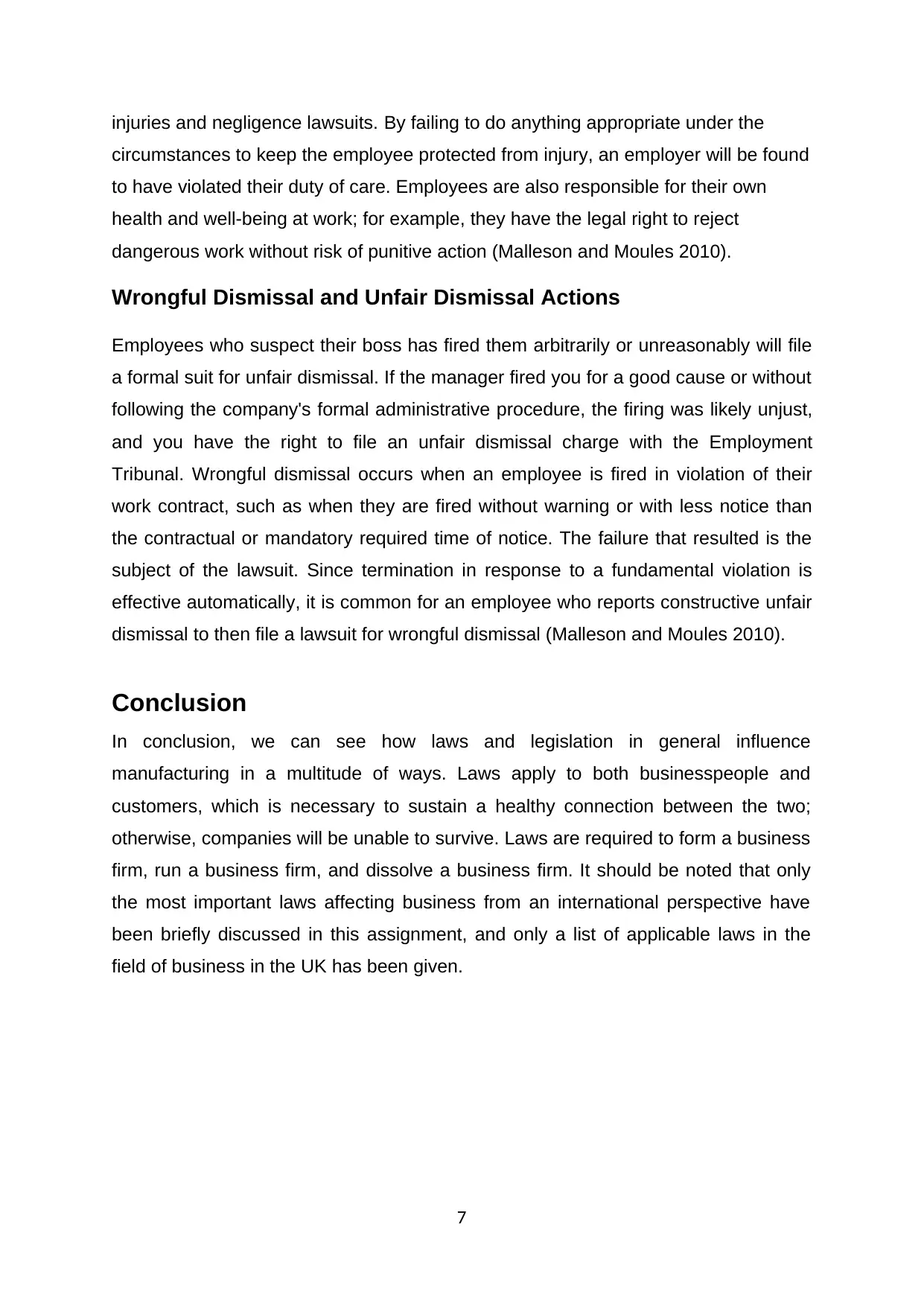
injuries and negligence lawsuits. By failing to do anything appropriate under the
circumstances to keep the employee protected from injury, an employer will be found
to have violated their duty of care. Employees are also responsible for their own
health and well-being at work; for example, they have the legal right to reject
dangerous work without risk of punitive action (Malleson and Moules 2010).
Wrongful Dismissal and Unfair Dismissal Actions
Employees who suspect their boss has fired them arbitrarily or unreasonably will file
a formal suit for unfair dismissal. If the manager fired you for a good cause or without
following the company's formal administrative procedure, the firing was likely unjust,
and you have the right to file an unfair dismissal charge with the Employment
Tribunal. Wrongful dismissal occurs when an employee is fired in violation of their
work contract, such as when they are fired without warning or with less notice than
the contractual or mandatory required time of notice. The failure that resulted is the
subject of the lawsuit. Since termination in response to a fundamental violation is
effective automatically, it is common for an employee who reports constructive unfair
dismissal to then file a lawsuit for wrongful dismissal (Malleson and Moules 2010).
Conclusion
In conclusion, we can see how laws and legislation in general influence
manufacturing in a multitude of ways. Laws apply to both businesspeople and
customers, which is necessary to sustain a healthy connection between the two;
otherwise, companies will be unable to survive. Laws are required to form a business
firm, run a business firm, and dissolve a business firm. It should be noted that only
the most important laws affecting business from an international perspective have
been briefly discussed in this assignment, and only a list of applicable laws in the
field of business in the UK has been given.
7
circumstances to keep the employee protected from injury, an employer will be found
to have violated their duty of care. Employees are also responsible for their own
health and well-being at work; for example, they have the legal right to reject
dangerous work without risk of punitive action (Malleson and Moules 2010).
Wrongful Dismissal and Unfair Dismissal Actions
Employees who suspect their boss has fired them arbitrarily or unreasonably will file
a formal suit for unfair dismissal. If the manager fired you for a good cause or without
following the company's formal administrative procedure, the firing was likely unjust,
and you have the right to file an unfair dismissal charge with the Employment
Tribunal. Wrongful dismissal occurs when an employee is fired in violation of their
work contract, such as when they are fired without warning or with less notice than
the contractual or mandatory required time of notice. The failure that resulted is the
subject of the lawsuit. Since termination in response to a fundamental violation is
effective automatically, it is common for an employee who reports constructive unfair
dismissal to then file a lawsuit for wrongful dismissal (Malleson and Moules 2010).
Conclusion
In conclusion, we can see how laws and legislation in general influence
manufacturing in a multitude of ways. Laws apply to both businesspeople and
customers, which is necessary to sustain a healthy connection between the two;
otherwise, companies will be unable to survive. Laws are required to form a business
firm, run a business firm, and dissolve a business firm. It should be noted that only
the most important laws affecting business from an international perspective have
been briefly discussed in this assignment, and only a list of applicable laws in the
field of business in the UK has been given.
7
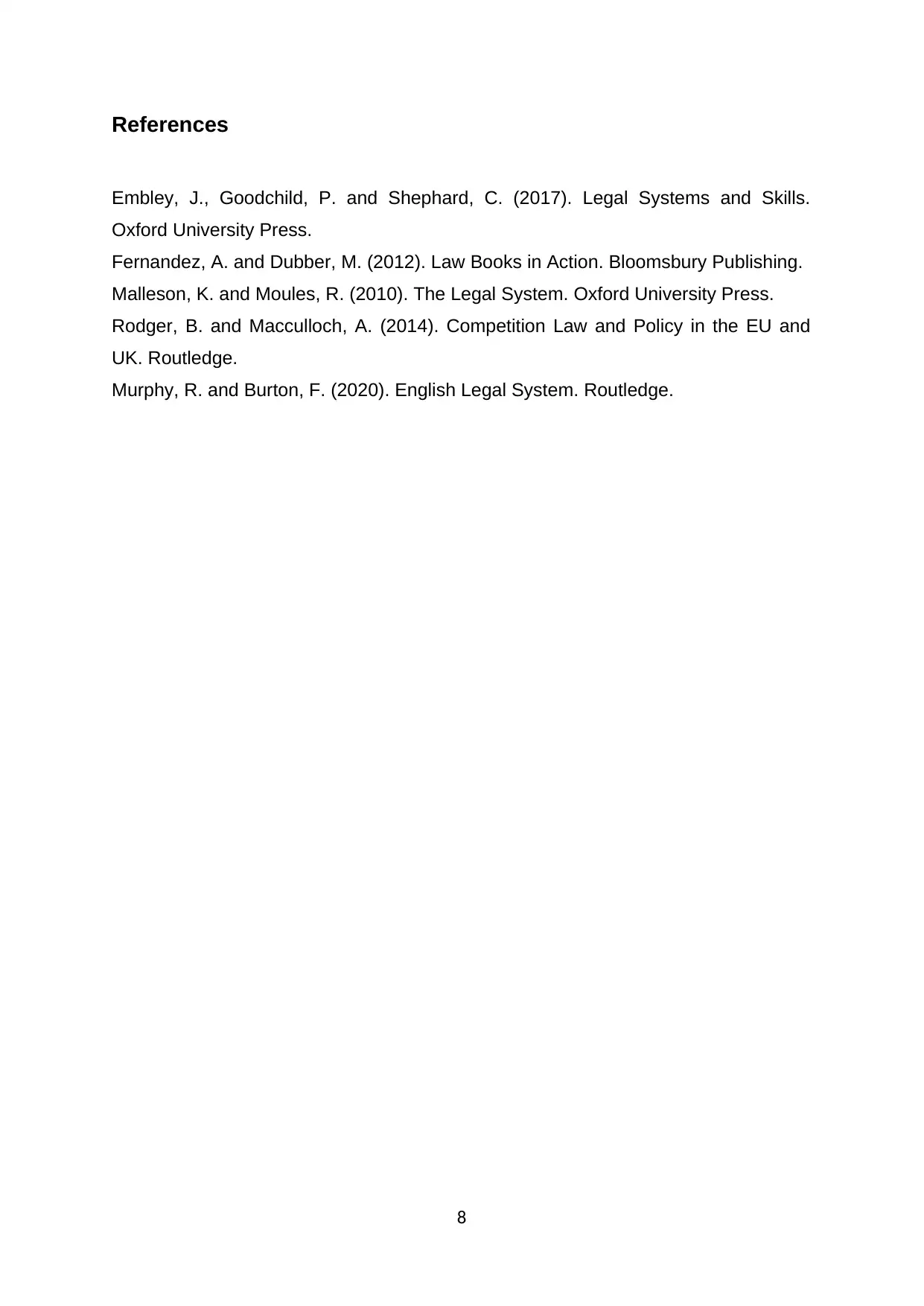
References
Embley, J., Goodchild, P. and Shephard, C. (2017). Legal Systems and Skills.
Oxford University Press.
Fernandez, A. and Dubber, M. (2012). Law Books in Action. Bloomsbury Publishing.
Malleson, K. and Moules, R. (2010). The Legal System. Oxford University Press.
Rodger, B. and Macculloch, A. (2014). Competition Law and Policy in the EU and
UK. Routledge.
Murphy, R. and Burton, F. (2020). English Legal System. Routledge.
8
Embley, J., Goodchild, P. and Shephard, C. (2017). Legal Systems and Skills.
Oxford University Press.
Fernandez, A. and Dubber, M. (2012). Law Books in Action. Bloomsbury Publishing.
Malleson, K. and Moules, R. (2010). The Legal System. Oxford University Press.
Rodger, B. and Macculloch, A. (2014). Competition Law and Policy in the EU and
UK. Routledge.
Murphy, R. and Burton, F. (2020). English Legal System. Routledge.
8
1 out of 9
Related Documents
Your All-in-One AI-Powered Toolkit for Academic Success.
+13062052269
info@desklib.com
Available 24*7 on WhatsApp / Email
![[object Object]](/_next/static/media/star-bottom.7253800d.svg)
Unlock your academic potential
© 2024 | Zucol Services PVT LTD | All rights reserved.

